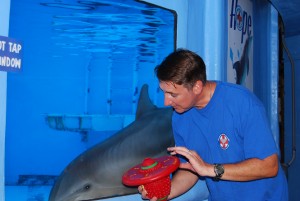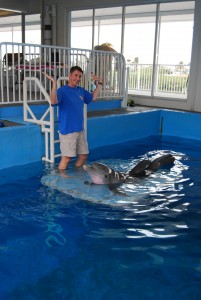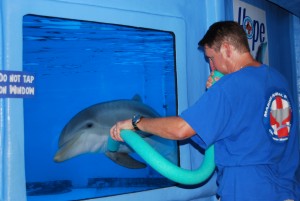A (UT) Dolphin Tale
You’ve heard the story: a spunky little dolphin who swims with a prosthetic tail. But there’s much more to the tale of Winter (now made into a Hollywood movie that opens this fall), and of UT alum Tom Orr, whose life continues to be enriched by:
Connections from the deep

Orr with a female calf named Hope. “She is a six-month-old female Atlantic bottlenose dolphin
found nursing on her deceased mother,” says Orr. “We have been raising her since the night the Hollywood movie wrapped up. A newspaper head line said it pretty well: ‘One Dolphin Tale ends and a new one begins.’”
Callings. They come on the phone, out of the deep blue sea and from somewhere in the heart.
Since he was a kid visiting his grandparents in Tampa, Florida, Tom Orr (A/S ’88) has felt that dolphins were calling to him. “There’s a popular tourist area called John’s Pass,” says the national account rep with marketing firm Valpak. “I remember as a young boy sitting there eating ice cream and watching dolphins. People with kayaks would go out to get closer and I would think, ‘Someday when I grow up, I want to be out there with those animals.’”
Years later and following a career relocation from Toledo to the Sunshine State in 1996, that promise led to Clearwater Marine Aquarium (CMA) on the Gulf of Mexico.
“It’s a nonprofit; not that many people knew about it at the time, but I’d heard how they rescue, rehabilitate and release dolphins,” he says. In those days, CMA made its home in a down-at-the-heels former sewage treatment plant. Orr joined the ranks of volunteers who took tickets at the front door, acted as tour guides and assisted the employees working with rescued dolphins and otters.
He upped the ante by joining CMA’s stranding team, the rescue group on call 24/7: “It could be at three a.m. or on Christmas Day, whenever a dolphin decides to come ashore. In most cases, we’ll try to bring the animal back to the facility and if they survive, try to rehabilitate them and release them back to the wild.”
Though his day job didn’t suffer, Orr says, there were times when even the adrenalin rush of a rescue couldn’t quite alleviate the effects of minimal sleep.
Nevertheless, he mustered when CMA took an urgent call from Florida’s Atlantic coast on a cold day in December 2005. A local fisherman had found something out in the shallow mangrove waters.
“She was an Atlantic bottlenose dolphin calf, maybe three or four months old,” Orr remembers. “She’d been entangled in a crab trap line that had been abandoned. She was completely wrapped up in the line, in terrible condition. A couple different rescue crews on the east coat of Florida got involved, including Sea World and Harbor Branch Marine.”
Even after she was freed, the calf was unable to swim away. As the rescuers carefully examined the writhing animal, it became obvious that cuts and abrasions were the least of her injuries. Like a rough but effective tourniquet, the trap lines had so tightly wrapped the end of her body that the blood flow to her flukes had been cut off for hours.
Tail flukes and the powerful muscles leading to them propel a dolphin through the water; an animal deprived of their use cannot swim. Faced with the extent of the calf’s trauma, the teams debated whether to euthanize her on the scene.
When apprized of the dolphin’s situation, CMA had other ideas.
“We told the rescuers that we were willing to take her under our care, so they transported her by truck across the state,” Orr says. “She arrived late at night and we unloaded her into to a small, above-ground swimming pool.”
Little did they know, he adds, that they were taking in an animal who would leave an indelible mark on the world.
Hollywood comes calling
 The pebble-in-the-global-pool claim isn’t made lightly. The young dolphin, christened Winter by her handlers at CMA, was destined to touch lives far beyond her enclosure. “She would help war veterans who were learning to walk again, she would inspire amputees, adults and children, all over the world, and she would become an internationally known symbol of hope and inspiration,” says Orr.
The pebble-in-the-global-pool claim isn’t made lightly. The young dolphin, christened Winter by her handlers at CMA, was destined to touch lives far beyond her enclosure. “She would help war veterans who were learning to walk again, she would inspire amputees, adults and children, all over the world, and she would become an internationally known symbol of hope and inspiration,” says Orr.
Winter’s story — how she ultimately lost her damaged tail, how scientists from a national prosthetics company (Hanger) became part of a growing army of fans and helpers — now seems a big-screen natural, but it was a boutique studio with a taste for inspirational stories that ended up making the call.
Alcon Entertainment, which had just come off a huge success with the film The Blind Side, noticed the media buzz about Winter and contacted CMA. “The talks went on for over a year, but early script drafts didn’t seem to be capturing Winter’s story,” Orr recalls.
Then actor/director Charles Martin Smith (yes, “Toad” of American Graffiti) became involved. “He’s one of the main reasons the film came together and came together so well,” Orr says. “After meeting Winter, he revised the script himself. He told us that the film was one of the most challenging things in his life. His mission became taking the spirit and energy of Winter and share it with the world.
“We believe he did an incredible job with it.”
Tom Orr was involved during the development of the movie — eventually titled Dolphin Tale — and watched it come together every step of the way. Over the years his participation in CMA had only strengthened as he joined its board of directors, serving as vice-chair, then chair.
In fact, as the film’s cast and crew got down to the actual movie-making, it became apparent that the aquarium-director role, assayed by Harry Connick Jr., was based at least in part on Orr himself.
He takes his moment of stardom lightly: “There’s an ongoing joke between me and the aquarium’s CEO, David Yates. I say that Connick is playing me, he says Connick is playing him. The truth is that the character is a combination of us and our veterinarian.”
No such shared glory for Winter; she played herself, with two of her regular trainers hired by the studio to work exclusively on teaching her dozens of new commands and new behaviors. “Winter thrived on it,” Orr says. “She got all kinds of attention and got to do new things. I think it was exciting for her to be the focal point for three months.” The studio paid the aquarium to close down last fall for the filming.
It goes beyond the bottom line, Orr believes. “Obviously like any film, this one has to make money, but I’ve gotta tell you, these guys were here and were really committed to the story. It wasn’t like a large business trying to figure out how to exploit the Winter story — they were a caring group of people.”
Like everyone at CMA, he’s anticipating a hit, noting, “The first director’s cut was viewed by some of Alcon’s top people and by focus groups. The feedback was outstanding. The only time they had such positive feedback was for The Blind Side.”
The man-animal bond
 No matter how exciting the upcoming movie opening, the work at CMA can’t slough off as whales, dolphins, other marine mammals and sea turtles make the journey toward recovery and release. A permanent resident in the now-enlarged facility, Winter may be one among many success stories, but her indomitable will to live and thrive is what connects her so viscerally to her many visitors.
No matter how exciting the upcoming movie opening, the work at CMA can’t slough off as whales, dolphins, other marine mammals and sea turtles make the journey toward recovery and release. A permanent resident in the now-enlarged facility, Winter may be one among many success stories, but her indomitable will to live and thrive is what connects her so viscerally to her many visitors.
“No one — including the aquarium staff and the veterinarians — thought she would survive once her tail came off, because no dolphin had ever had. But no one told Winter that. She has a spirit like no other animal I’ve ever worked with,” says Orr.
She’s become an international inspiration, he adds. “We’ve seen so many people come to the aquarium and have a life-changing experience when they view Winter. I had a co-worker whose nephew lost his leg in a tragic truck accident and was suffering from serious depression as a result. It took just one thirty-minute encounter with Winter to go from being depressed and self-conscious to joking about his leg.”
Brock Mealer from Wauseon, Ohio, whose brother is on the University of Michigan football team, was another person touched by Winter. He’d been left paralyzed after a horrific car accident that killed his father and left Brock with a 1 percent chance of walking again.
Tom takes up the story: “We became friends through Facebook and I invited him down to met Winter, when Michigan played in Gator Bowl. Brock and his girlfriend came down, and I had him in the water with Winter. There were a lot of parallels in their stories.”
Mealer told a Florida reporter that he’d felt a connection with Winter as soon as he heard her story. “I thought at some time Winter must have wondered if she’d make it or if she was going to die,” he said, admitting that he knew the feeling.
“But now Brock walks,” Orr says. “He led the Wolverines out onto the field for the team’s opener last fall, in front of 113,000 fans cheering for him.”
As for Tom Orr, he’ll keep following the calling he’s found at CMA. “It recharges the very spirit of my being,” he says.
He pauses a long moment, then says, “You know, I had an experience the night of 9/11. Like most of us, our world turned upside down that day. I was scheduled for one of my late-night shifts to help rehabilitate a whale, a juvenile sperm whale named George.
“I found myself alone in the water with a whale in a rainstorm that night. There was a connection between us, almost like being with a species from another planet. Their world is so different from ours, and they have such an intelligence. The average person who’s not so closely involved can see whales and dolphins do amazing tricks, realize they’re athletic and smart beyond a dog, but until you look into the eyes and the soul of a whale on the night of 9/11, or see the spirit in Winter’s eyes — well, you don’t really know.”
Dolphin Tale is slated to open September 23. See a preview at: www.imdb.com/video/imdb/vi3789528345/.
Another example of the power of Winter’s story, from the Facebook page of Dolphin’s Way: http://www.facebook.com/note.php?note_id=220820314614574






